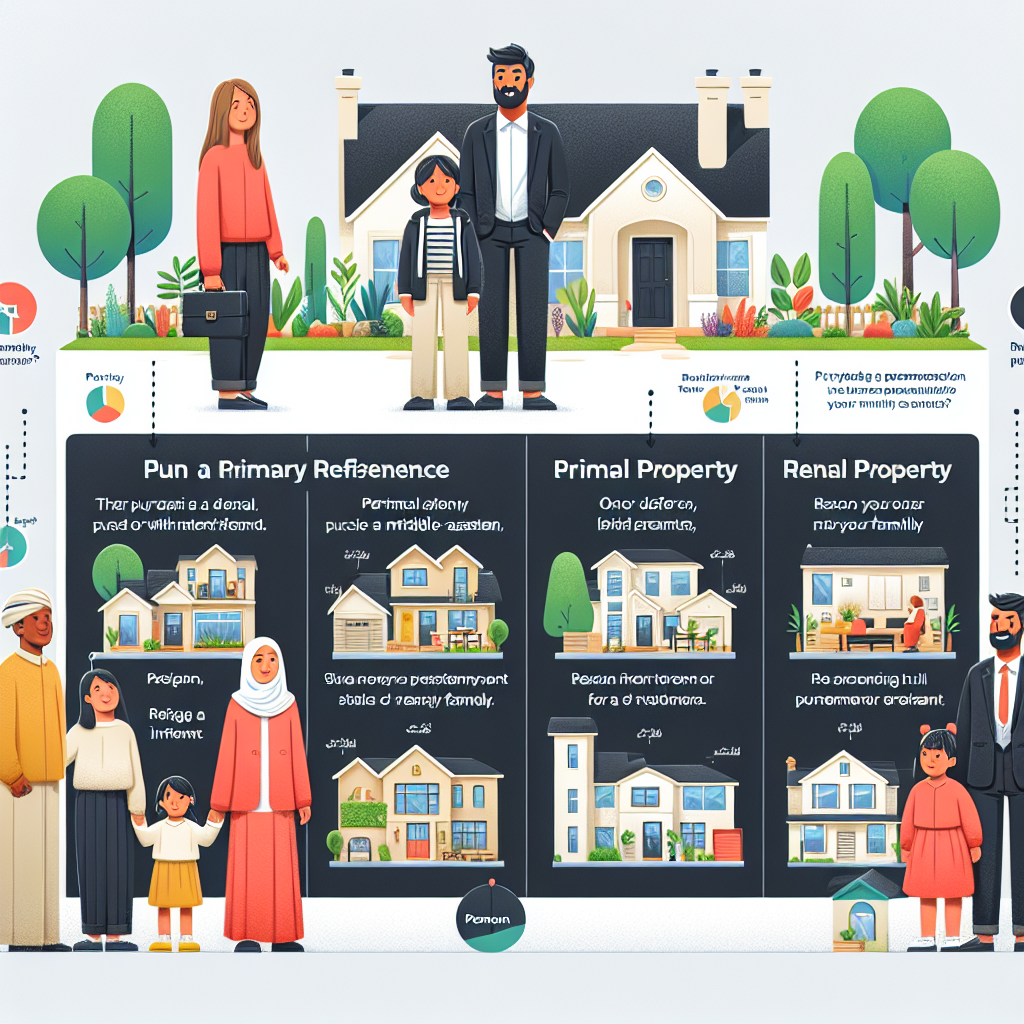-
Table of Contents
- Key Differences Between Purchasing a Rental Property and a Primary Residence
- Financial Considerations
- Down Payment Requirements
- Interest Rates
- Tax Implications
- Location and Market Analysis
- Primary Residence
- Rental Property
- Property Management and Maintenance
- Primary Residence
- Rental Property
- Financing Options
- Primary Residence
- Rental Property
- Risk and Return on Investment
- Primary Residence
- Rental Property
- Emotional vs. Business Decision
- Primary Residence
- Rental Property
- Case Studies
- Case Study 1: Primary Residence Purchase
- Case Study 2: Rental Property Investment
- Conclusion
Key Differences Between Purchasing a Rental Property and a Primary Residence

Investing in real estate can be a lucrative venture, but the approach to purchasing a rental property differs significantly from buying a primary residence. Understanding these differences is crucial for making informed decisions that align with your financial goals and lifestyle needs. This article delves into the key distinctions between purchasing a rental property and a primary residence, providing valuable insights, examples, and statistics to guide prospective buyers.
Financial Considerations
Down Payment Requirements
One of the most notable differences between purchasing a rental property and a primary residence is the down payment requirement. For a primary residence, buyers can often secure a mortgage with a down payment as low as 3-5% of the property’s value, especially if they qualify for government-backed loans such as FHA or VA loans. In contrast, lenders typically require a down payment of at least 20-25% for rental properties due to the higher risk associated with investment properties.
Interest Rates
Interest rates for rental property mortgages are generally higher than those for primary residences. Lenders view rental properties as riskier investments because they depend on tenant occupancy and rental income. As a result, investors can expect to pay an interest rate that is 0.5% to 1% higher than the rate for a primary residence mortgage.
Tax Implications
Tax considerations also vary between rental properties and primary residences. Homeowners can deduct mortgage interest and property taxes on their primary residence, potentially reducing their taxable income. Additionally, if they sell their primary residence, they may qualify for a capital gains exclusion of up to $250,000 ($500,000 for married couples) if they meet certain criteria.
On the other hand, rental property owners can deduct a wider range of expenses, including:
- Mortgage interest
- Property taxes
- Insurance premiums
- Maintenance and repairs
- Property management fees
- Depreciation
These deductions can significantly reduce the taxable income generated by the rental property. However, when selling a rental property, investors are subject to capital gains tax on the profit, although they can defer this tax through a 1031 exchange if they reinvest the proceeds in another rental property.
Location and Market Analysis
Primary Residence
When purchasing a primary residence, buyers often prioritize factors such as proximity to work, quality of local schools, neighborhood safety, and community amenities. Personal preferences and lifestyle needs play a significant role in the decision-making process. For example, a family with young children may prioritize a home in a suburban area with excellent schools and parks, while a young professional might prefer a condo in a bustling urban center.
Rental Property
Investors looking to purchase a rental property must adopt a different approach, focusing on market analysis and potential return on investment (ROI). Key factors to consider include:
- Rental demand: Areas with high rental demand, such as college towns or cities with a strong job market, are more likely to provide consistent rental income.
- Rental rates: Researching local rental rates helps investors determine whether the property can generate sufficient income to cover expenses and provide a profit.
- Property appreciation: While rental income is crucial, potential property appreciation can also contribute to long-term investment returns.
- Vacancy rates: High vacancy rates can indicate a saturated rental market, making it more challenging to find tenants and maintain consistent income.
For instance, an investor might choose to purchase a rental property in a growing city with a strong job market and low vacancy rates, ensuring a steady stream of potential tenants and rental income.
Property Management and Maintenance
Primary Residence
Homeowners are responsible for maintaining their primary residence, which includes routine tasks such as lawn care, cleaning, and minor repairs. While some homeowners may choose to hire professionals for certain tasks, they are generally more involved in the day-to-day upkeep of their property.
Rental Property
Managing a rental property can be more complex and time-consuming, especially for investors with multiple properties or those who live far from their investment. Property management responsibilities include:
- Finding and screening tenants
- Collecting rent
- Handling maintenance and repairs
- Addressing tenant concerns and disputes
- Ensuring compliance with local landlord-tenant laws
Many investors choose to hire a property management company to handle these tasks, which typically charges a fee of 8-12% of the monthly rental income. While this reduces the investor’s involvement, it also impacts the overall profitability of the rental property.
Financing Options
Primary Residence
Homebuyers have access to a variety of financing options when purchasing a primary residence, including conventional loans, FHA loans, VA loans, and USDA loans. These options often come with favorable terms, such as lower down payments and competitive interest rates, making homeownership more accessible for a broader range of buyers.
Rental Property
Financing a rental property can be more challenging, as lenders typically have stricter requirements for investment properties. Investors may need to demonstrate a strong credit history, higher income, and substantial cash reserves to qualify for a mortgage. Additionally, some financing options available for primary residences, such as FHA and VA loans, are not applicable to rental properties.
However, investors can explore alternative financing options, such as:
- Portfolio loans: Offered by some lenders, these loans are designed for investors with multiple properties and may have more flexible terms.
- Hard money loans: Short-term loans provided by private lenders, often used for property flips or renovations. These loans typically have higher interest rates and shorter repayment terms.
- Commercial loans: Suitable for investors purchasing multi-family properties or commercial real estate, these loans often have different qualification criteria and terms compared to residential mortgages.
Risk and Return on Investment
Primary Residence
Purchasing a primary residence is generally considered a lower-risk investment compared to rental properties. Homeowners build equity over time as they pay down their mortgage and benefit from property appreciation. Additionally, owning a home provides stability and the potential for long-term financial growth.
However, primary residences are not typically purchased with the primary goal of generating income. While homeowners may experience significant appreciation in property value, the return on investment is often realized only when the property is sold.
Rental Property
Investing in rental properties can offer higher potential returns but also comes with increased risk. Rental income can provide a steady cash flow, and property appreciation can contribute to long-term wealth. However, investors must navigate challenges such as tenant turnover, property maintenance, and market fluctuations.
To mitigate risk and maximize returns, investors should conduct thorough market research, carefully screen tenants, and maintain a diversified portfolio of properties. For example, an investor with properties in different cities or neighborhoods may be better positioned to weather local market downturns and maintain consistent rental income.
Emotional vs. Business Decision
Primary Residence
Purchasing a primary residence is often an emotional decision, influenced by personal preferences, family needs, and lifestyle considerations. Homebuyers may prioritize features such as a spacious kitchen, a large backyard, or proximity to friends and family. The emotional attachment to a primary residence can also impact decisions related to maintenance, renovations, and eventual sale.
Rental Property
In contrast, purchasing a rental property is primarily a business decision driven by financial considerations. Investors must evaluate properties based on their potential to generate income and appreciate in value, rather than personal preferences. This objective approach helps investors make informed decisions that align with their financial goals and risk tolerance.
Case Studies
Case Study 1: Primary Residence Purchase
Jane and John, a married couple with two young children, decided to purchase their first home in a suburban neighborhood known for its excellent schools and family-friendly amenities. They secured an FHA loan with a 3.5% down payment and a competitive interest rate. Over the years, they made several improvements to their home, including updating the kitchen and adding a backyard play area for their children.
When Jane and John decided to sell their home after ten years, they benefited from significant property appreciation and were able to exclude $500,000 of their capital gains from taxes. The emotional attachment to their home and the improvements they made contributed to their overall satisfaction and financial success.
Case Study 2: Rental Property Investment
Mike, an experienced real estate investor, purchased a multi-family rental property in a growing city with a strong job market. He conducted thorough market research, identifying an area with high rental demand and low vacancy rates. Mike secured a conventional loan with a 25% down payment and hired a property management company to handle tenant screening, rent collection, and maintenance.
Over the years, Mike’s rental property generated consistent rental income, allowing him to cover expenses and achieve a positive cash flow. Additionally, the property’s value appreciated, contributing to his long-term wealth. By maintaining a business-focused approach and leveraging professional property management, Mike successfully navigated the challenges of rental property ownership and achieved his investment goals.
Conclusion
Purchasing a rental property and a primary residence involves distinct considerations, from financial requirements and tax implications to property management and emotional factors. Understanding these key differences is essential for making informed decisions that align with your financial goals and lifestyle needs.
For primary residence buyers, factors such as down payment options, interest rates, and personal preferences play a significant role in the decision-making process. In contrast, rental property investors must focus on market analysis, potential ROI, and effective property management to achieve success.
By carefully evaluating these differences and conducting thorough research, prospective buyers can make strategic decisions that support their long-term financial objectives and personal aspirations. Whether purchasing a home for personal use or investing in rental properties, understanding the unique challenges and opportunities of each approach is crucial for achieving success in the real estate market.








